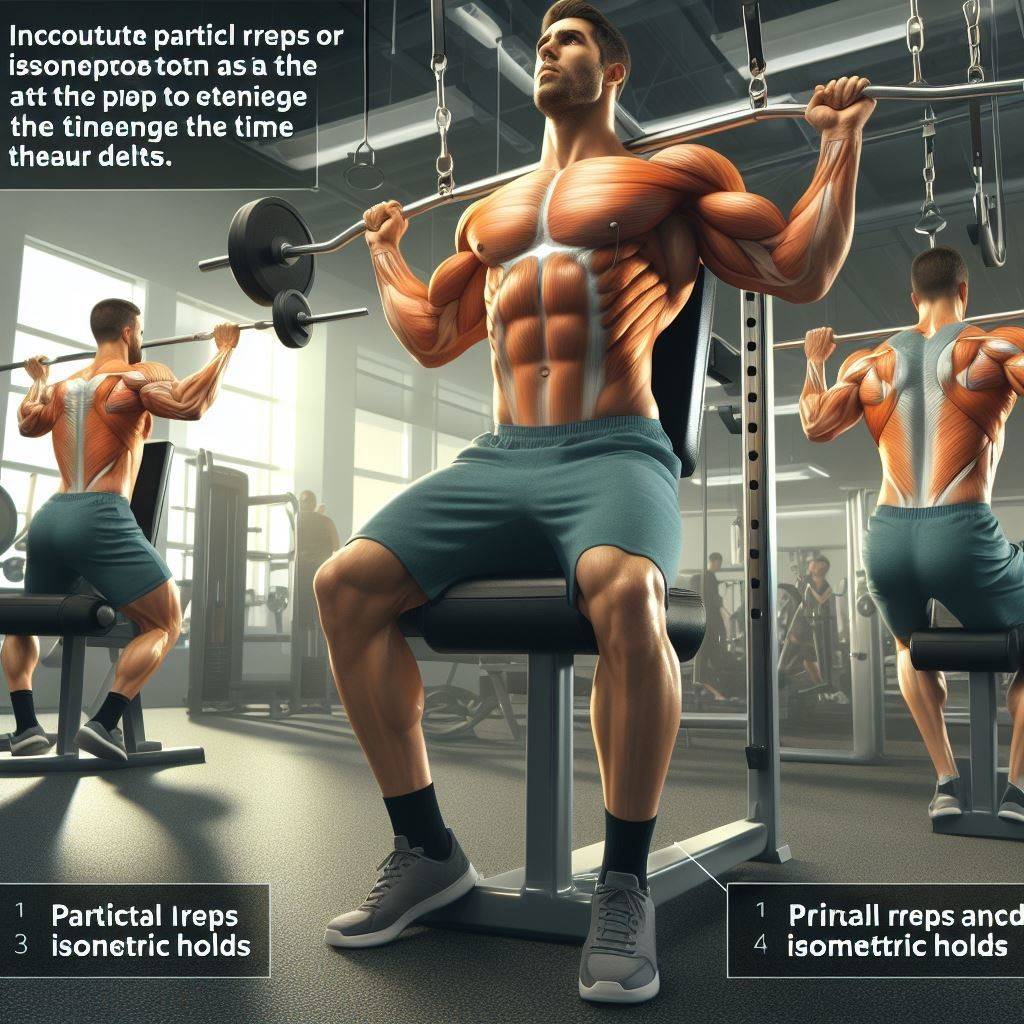Dumbbell Rear Delt Fly: Build a Stronger, More Stable Shoulder Girdle
Discover the effectiveness of incorporating the Dumbbell Rear Delt Fly into your routine to develop more robust rear shoulder muscles, enhance stability, reduce injury risks, and attain a well-proportioned body.
The Importance of Rear Delt Fly Development
In the pursuit of a well-rounded physique and optimal shoulder health, one muscle group that often gets overlooked is the rear deltoids. While the front and middle delts tend to get ample attention through exercises like shoulder presses and lateral raises, the rear delts are frequently neglected, leading to muscle imbalances and potential injury risks.
Developing strong rear deltoids is crucial for several reasons:
- Shoulder Stability: The rear delts work in conjunction with other shoulder muscles to stabilize the shoulder joint during various movements, reducing the risk of injury and enhancing overall shoulder function.
- Posture Improvement: Strong rear delts help counteract the rounding of the shoulders caused by prolonged sitting or poor posture, promoting a more upright and confident stance.
- Balanced Muscularity: Neglecting the rear delts can lead to disproportionate shoulder development, resulting in an asymmetrical and aesthetically unpleasing physique.
- Injury Prevention: Muscle imbalances around the shoulder joint can increase the risk of common injuries, such as rotator cuff strains or impingement issues.
To address these concerns and achieve optimal shoulder health and development, incorporating targeted exercises like the dumbbell rear delt fly into your routine is essential.
What does the Dumbbell Rear Delt Fly entail?
The Dumbbell Rear Delt Fly, sometimes called the bent-over rear delt to raise or reverse fly, is a straightforward yet efficient workout designed to specifically engage the rear deltoid muscles. This compound movement not only engages the rear delts but also involves the trapezius, rhomboids, and other supporting muscles in the upper back and shoulders.
In the dumbbell rear delt fly, you lean forward from the hips, grasping a dumbbell in each hand with your palms inward. Then, you lift the weights outwards to the sides, focusing on bringing your shoulder blades together at the peak of the motion. Afterward, you gradually lower the weight back to the initial position.
This exercise is particularly effective for several reasons:
- Isolation: The dumbbell rear delt fly isolates the rear deltoids, allowing you to focus on developing these often-neglected muscles specifically.
- Range of Motion: The movement promotes a full range of motion for the rear delts, ensuring optimal muscle fiber activation and development.
- Functional Strength: By engaging the stabilizing muscles of the shoulder girdle, The dumbbell rear delt fly improves practical strength and stability, benefiting both daily tasks and athletic endeavours.
- Versatility: This exercise can be performed in various positions (seated, standing, or bent over) and with different resistance levels (dumbbells, resistance bands, or cables), allowing for customization based on your fitness level and goals.
When incorporated into a well-rounded strength training program, the dumbbell rear delt fly is effective in developing shoulder strength and stability, leading to improved shoulder health and function., improves your posture, and achieves a balanced, aesthetically pleasing physique.
Proper Form and Technique for Dumbbell Rear Delt Fly

Performing the dumbbell rear delt fly accurately is essential for optimizing its efficiency while reducing the chance of harm. Grab a pair of dumbbells and stand with your feet shoulder-width apart Here’s a step-by-step guide to performing this exercise correctly:
- Hold two dumbbells and position yourself with your feet at a distance equal to the width of your shoulders. Hing forward at the hips, keeping your back straight and core engaged. Your torso should be nearly parallel to the floor, with a slight bend in the knees.
- Grasp the dumbbells using an overhand grip, ensuring that your palms are oriented toward each other. Allow the weights to hang straight down from your shoulders, with your arms extended and a slight bend in the elbows.
- Initiate the movement by squeezing your shoulder blades together, raising the dumbbells outward and slightly backward until your arms are parallel to the floor. Focus on engaging the rear deltoids and avoid excessive arching or twisting of the back.
- Pause briefly at the top of the movement, squeezing the rear delts, then slowly lowering the weights back to the starting position in a controlled motion.
- Maintain a neutral wrist position throughout the exercise and avoid swinging or using momentum to lift weights.
- Breathe deeply, exhaling as you raise the weights and inhaling as you lower them.
It’s essential to use proper form and control the movement throughout the entire range of motion. Avoid swinging or jerking the weights, as this can increase the risk of injury and reduce the effectiveness of the exercise.
Variations and Progressions for Dumbbell Rear Delt Fly
The traditional dumbbell rear delt fly stands out as a superb workout option. Incorporating variations can help target the rear delts from different angles and add variety to your routine. Here are some popular variations and progressions:
1. Seated Rear Delt Fly:

Perform the exercise while seated on a bench, with your torso leaning slightly forward. This variation can be easier on the lower back for those with pre-existing conditions.
2. Standing Rear Delt Fly:
Instead of bending forward, perform the exercise while standing upright, with a slight forward lean from the hips. This variation can improve postural awareness and core engagement.
3. Incline Rear Delt Fly:
Perform the exercise while leaning forward on an incline bench, with your chest supported and your torso at an angle. This variation can target the rear delts from a different angle and increase the range of motion.
4. Resistance Band Rear Delt Fly:
Use resistance bands instead of dumbbells for constant tension throughout the movement and increased time under tension.
5. Single-Arm Rear Delt Fly:
Perform the exercise with one arm at a time, using your non-working hand for support on a bench or surface. This variation can help identify and address any strength imbalances between sides.
6. Partial Reps and Isometric Holds:

Incorporate partial reps or isometric holds at the top of the movement to increase the time under tension and further challenge the rear delts.
As you progress and become stronger, you can increase the resistance (dumbbell weight or band tension) or incorporate these variations to continue challenging your rear delts and maintaining consistent progress.
Programming and Frequency
To effectively target and develop the rear deltoids, it’s crucial to incorporate the dumbbell rear delt fly into your training routine consistently and with proper programming. Here are some guidelines for programming and frequency:
- Volume and Intensity: Aim for 2-4 sets of 10-15 repetitions per dumbbell rear delt fly Use a weight that challenges you in the prescribed rep range, but allows you to maintain proper form.
- Frequency: Include the dumbbell rear delt fly or its variations 1-2 times per week, allowing for proper rest and recovery between sessions.
- Exercise Order: Perform the dumbbell rear delt fly after your primary compound exercises (e.g., bench press, overhead press, rows) to ensure you have sufficient energy and focus to execute the movement correctly.
- Rest Periods: Allow for 60-90 seconds of rest between sets to facilitate recovery and maintain proper form throughout your working sets.
- Progressive Overload: Gradually increase the resistance (dumbbell weight or band tension) or number of sets and reps over time to continue challenging the rear delts and promote muscular development.
- Balanced Routine: The traditional dumbbell rear delt fly stands out as a superb workout option, it’s essential to incorporate it into a well-rounded routine that addresses all major muscle groups and movement patterns. Neglecting other areas can lead to muscular imbalances and potential injuries.
- Individual Considerations: Your specific programming and frequency may need to be adjusted based on factors such as your training experience, goals, and any pre-existing injuries or limitations. Consulting with a qualified fitness professional can help ensure a tailored approach.
By following these programming guidelines and consistently including the dumbbell rear delt fly in your routine, you’ll be well on your way to building stronger, more stable shoulders and achieving a balanced, aesthetic physique.
Complementary Exercises
The dumbbell rear delt fly stands out as a fantastic workout choice to specifically engage the muscles in the rear deltoid region, incorporating complementary exercises can further enhance your shoulder development and overall upper body strength. Here are some effective exercises to consider:
- Face Pulls: This exercise targets the rear delts, as well as the rotator cuff muscles and upper back, promoting shoulder stability and posture.
- Bent-Over Rows: Variations of the bent-over row, such as dumbbell rows or barbell rows, work the rear delts, lats, and other back muscles, contributing to a well-rounded back and shoulder development.
- Lateral Raises: This exercise targets the medial deltoids, helping to create balanced shoulder development when combined with rear delt exercises.
- Upright Rows: Upright rows work the deltoids, trapezius, and other shoulder stabilizers, complementing the dumbbell rear delt fly for overall shoulder strength and stability.
- Push-Ups and Push-Up Variations: While primarily targeting the chest and triceps, push-ups and their variations also engage the deltoids, including the rear delts, promoting functional strength and stability.
- Shoulder Presses: Overhead pressing exercises like the military press or dumbbell shoulder press work the front and medial deltoids, as well as the rear delts to a lesser extent, contributing to overall shoulder development.
By incorporating these complementary exercises into your routine, you’ll not only target the rear delts effectively but also develop a well-rounded and balanced physique, enhancing your overall strength, stability, and athletic performance.
FAQs: dumbbell rear delt fly
What does rear delt fly work?
The dumbbell rear delt fly primarily targets and works the rear deltoid muscles (posterior delts), which are located at the back of the shoulder. This exercise also engages the trapezius, rhomboids, and other stabilizing muscles in the upper back and shoulders.
Is dumbbell back fly’s effective?
Yes, dumbbell rear delt flies (also known as bent-over rear delt raises or reverse fly’s) are an effective exercise for targeting and developing the rear deltoid muscles. When performed with proper form and progressive overload, they can help build stronger, more stable shoulders, and improve overall posture.
How to do standing rear delt flys?
To perform standing rear delt flys:
- Stand with your feet shoulder-width apart, holding a dumbbell in each hand with an overhand grip.
- Hinge forward at the hips, keeping your back straight and core engaged. Your torso should be slightly leaning forward.
- With a slight bend in the elbows, raise the dumbbells out to the sides until your arms are parallel to the floor, squeezing your shoulder blades together.
- Pause briefly Afterward, descend the weights gradually to the initial position, ensuring a controlled movement throughout the process.
- Maintain proper form and avoid swinging or arching the back throughout the movement.
What weight is the rear delt fly?
The appropriate weight for the dumbbell rear delt fly will vary depending on your strength level and experience. As a general guideline, choose a weight that allows you to perform the exercise with proper form for the desired number of reps (usually 10-15 reps per set). Start light and gradually increase the weight as you build strength and endurance in the rear delts.
By providing comprehensive information, including key takeaways, detailed explanations, complementary exercises, potential limitations, and FAQs, this article aims to be a valuable resource for those looking to incorporate the dumbbell rear delt fly into their fitness routine effectively and safely.
Conclusion
The dumbbell rear delt fly is a powerful and effective exercise for targeting the often-neglected rear deltoid muscles. By incorporating this movement into your routine, you’ll not only build stronger and more stable shoulders but also promote better posture, prevent muscle imbalances, and achieve a well-rounded, aesthetic physique.
Remember, proper form and technique are crucial for maximizing the benefits of the dumbbell rear delt fly while minimizing the risk of injury. Follow the programming guidelines, incorporate complementary exercises, and listen to your body to adjust as needed.
Consistent dedication to training the rear delts, combined with a balanced routine and a commitment to overall fitness, will pave the way for achieving your strength, stability, and aesthetic goals



